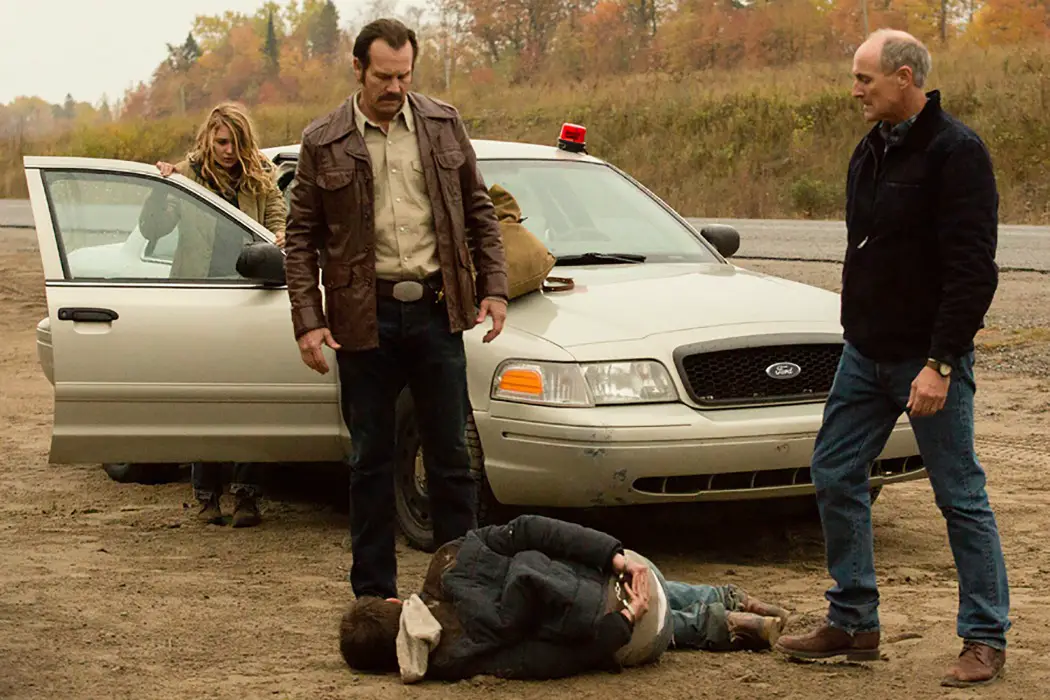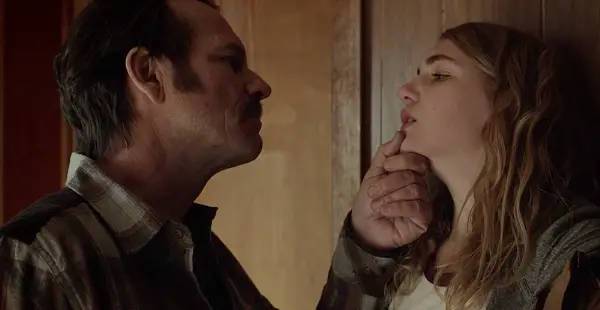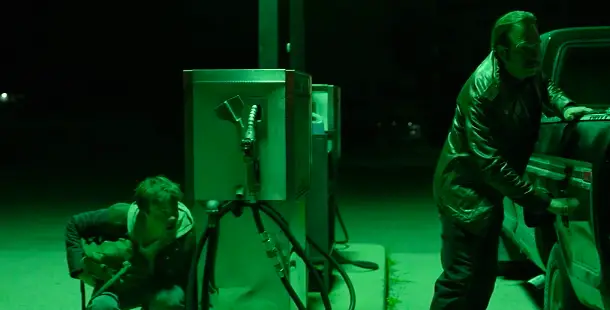MEAN DREAMS Exemplifies The Power of Good Storytelling & Bill Paxton

Chris is a B.A.H. graduate with a concentration in pre-19th…
Mean Dreams is the familiar story of two young people, Casey and Jonas, (played by Sophie Nélisse and Josh Wiggins) hoping to leave their claustrophobic town. Except they have to deal with Casey’s father Wayne (the late Bill Paxton), whose dirty little secrets extend beyond abusing his daughter. His occupation as a local police officer on the take creates problems after Jonas witnesses him committing murder and walking away with a bag full of money.
In only his second feature, director Nathan Morlando makes interesting directorial choices, so as to not present the same old thing we’ve seen before. Writers Kevin Coughlin and Ryan Grassby are no small part of the equation. Instead of expository dialogue in each scene, their screenplay shows us more than it tells; even then a certain amount of suggestion comes into play. Finally, it’s Paxton, in one of his last few roles, who does the heavy lifting. He imbues his character with a quiet menace revealing itself further over time, tainting everything it touches.

Countless films have told stories such as this one. Like Roger Ebert once said: “It’s not what a movie is about, it’s how it is about it.” Morlando succeeds with this time worn story of young love, big dreams, and those who get in the way by telling it in a sophisticated way. Equal parts drama and thriller, Mean Dreams is less about action set pieces, more about the buried secrets in the lives of its characters breaching the surface.
Small Town Life & Freedom
Morlando’s directing is confident, in that he doesn’t feel the need to fill his film with action or quick cuts to build tension. We start off in the wide open spaces of a farming town where Jonas (Wiggins) and Casey (Nélisse) meet one another. Sault Ste. Marie located in Ontario, Canada serves as the breathtaking backdrop of the film. This natural beauty is where a theme of freedom begins in a juxtaposition of light versus dark.
The cinematography courtesy of Steve Cosens expresses how living in an isolated town can suppress the freedom of the young. In those open spaces, the shots are bright and vibrant. Yet once we move indoors, particularly in the house Casey shares with her father Wayne (Paxton), the shots become dark and draped in shadows. As the film progresses and the freedom of the young couple is further compromised, Cosens takes us deeper into that darkness.
During the opening credits the camera floats through a beautiful, natural landscape in the fields of farmland, as if we’re immediately in a dream. Then the young dreamers of our story first meet like the beginning of some fairy tale. By the climactic scenes the cinematography is sombre, matching the dire situation in which Jonas and Casey find themselves. Just as the light motif is corrupted by the dark, so does Paxton’s performance threaten the goodness of everything around him.
Bill Paxton: An Actor’s Actor
Not to take anything away from Nélisse or Wiggins, they’re actually fantastic. It’s impossible to deny the force of Paxton as Wayne Caraway, crooked cop and even nastier father. He portrays nuance in his character with subtlety: when he grabs his daughter’s hand holding it to his pulse as if to taunt her with the fact he’s still healthy, still living; or how the look in his eyes changes when Jonas is around and his perceived status as top male is threatened.
The pain of losing Paxton is compounded by the fact he was such a fine actor. In many roles he played over the years, even in serious films, his energy comes off as exciting and fun. Not the case in this role. He is as dark as ever. More than that, his character and performance speaks to the reality of many abusers. Just like real life, abuse is often concealed, not spoken aloud or articulated through words; it is seen in the shadowy moments behind closed doors and only in fleeting images to the outside world.

In a similar vein to the way Paxton gradually reveals more of Wayne’s menace, the screenplay overall does the story service by not spelling every last thing out for the audience. Even in the scenes where we’re shown the story, not told, Morlando’s direction provides elusive moments where what we don’t see is more telling than what we do.
Showing Not Telling & Not Showing At All
During countless moments co-writers Coughlin and Grassby could tell us too much via dialogue. There are also times when the dialogue remains only suggestive. Their willingness to show and not tell makes Mean Dreams engaging because it doesn’t assume its audience can’t put pieces together themselves.
For instance, a character like Casey in another movie might go on about how she’s never been anywhere other than rural America, how she moves from one small town to another. Here, she simply tells Jonas: “It’s always been my dream to see the ocean one day.” There are pieces of exposition that are necessary. For the most part the story and the characters lives come at us by way of provocative storytelling.

The best example is when Jonas hides in the covered pan of a truck while Wayne meets several men on ATVs to exchange a bag of money. He chooses to shoot them, though we’re not shown the shooting. Rather, we witness the moment from Jonas’ perspective. Only privy to a rectangle of space at the edge of the truck, we see the flare of a gun and hear its shots, we don’t even see the bodies. Morlando’s choice not to show the multiple murder makes this scene more unsettling, likewise playing into the shadowy character of Wayne.
Conclusion
Ultimately, the dilemma of Jonas and Casey is intriguing. They’re forced to reckon with the ruthless corruption of the tiny town from which they hope to escape, where each person is more crooked than the last. In the end they must be as violent as the people they’re fleeing, or else face a fate worse than death.
For a story we’ve seen time and time again, Mean Dreams is compelling. It doesn’t take all the traditional routes expected of a thriller about young people seeking a better life away from the abuse and repetitive, soul sucking drama in their hometown. Not only that, the screenplay appropriately uses the medium of film by showing us the story, which makes the dialogue and exposition we do get feel enigmatic.
The story itself is dark, particularly driven by the fearsome performance of Paxton, whose legacy is only strengthened by one of his final performances. Although hope is never rescinded entirely, reflected in the visual motif starting off light, growing darker, before returning full circle to a tender moment in the sun at the end. So many thrillers out there feel saturated with convoluted writing and needless visual post-production. Mean Dreams keeps it simple by letting the story unfold organically and allowing the camera to do the talking.
Considering the plot-initiating scene of Mean Dreams when Wayne commits murder: is it more thrilling to obscure and suggest violence, or would seeing it have more an impact on the viewer?
Mean Dreams is currently on general release in select US theatres. All international release dates are here.
Does content like this matter to you?
Become a Member and support film journalism. Unlock access to all of Film Inquiry`s great articles. Join a community of like-minded readers who are passionate about cinema - get access to our private members Network, give back to independent filmmakers, and more.
Chris is a B.A.H. graduate with a concentration in pre-19th century literature from Memorial University of Newfoundland. His short stories have been published in The Cuffer Anthology Volumes VI & VII, as well as upcoming stories in new anthologies from Centum Press (One Hundred Voices & One Hundred Voices Pt. II) and Science Fiction Reader. A short screenplay of his titled "New Woman" is currently being produced, to be shot in 2017; it is a female-led dramatic horror, a period piece set in 1888.













